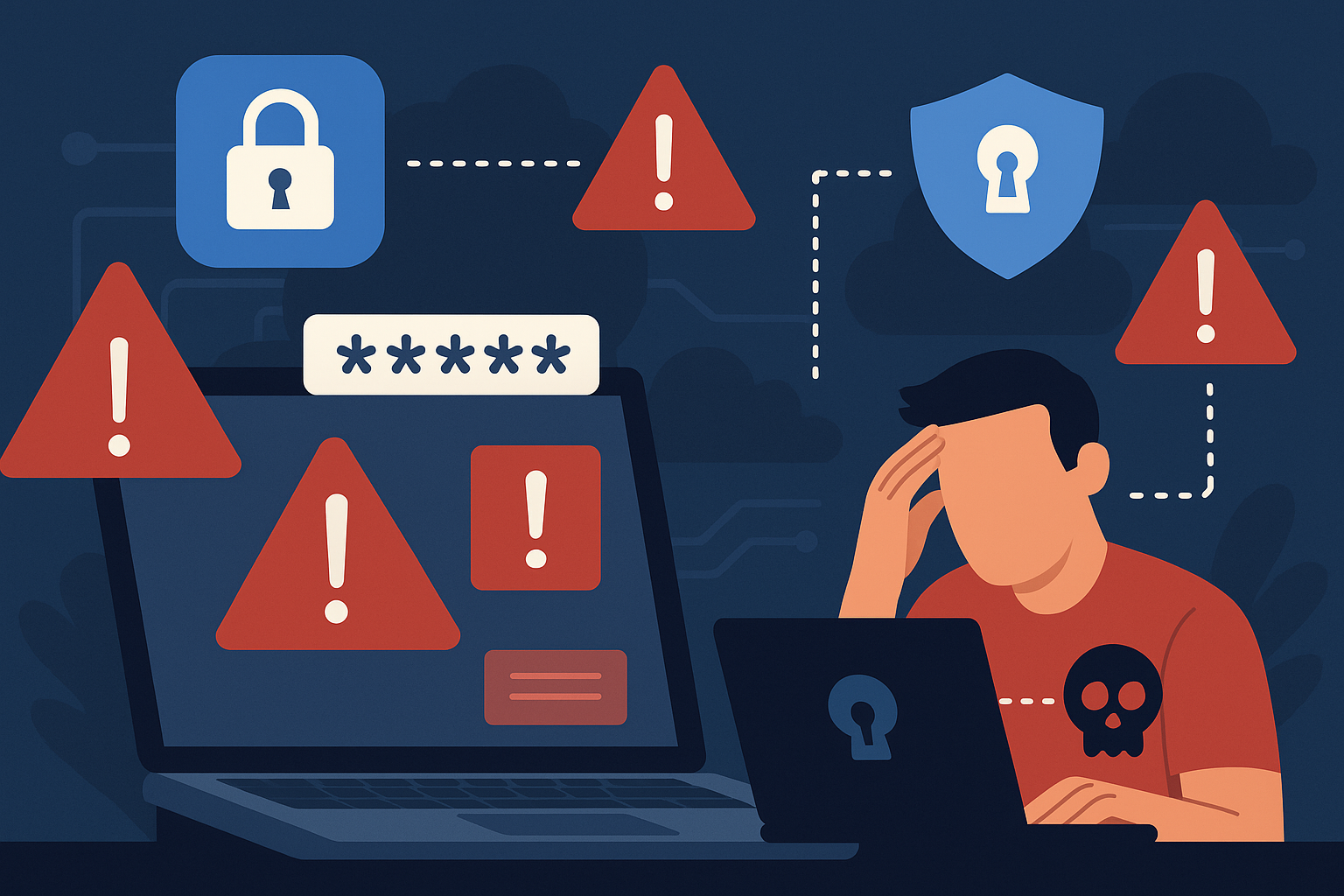A new study from Ontario Tech University, PureSquare, and CQR Cybersecurity is shedding light on a paradox at the heart of modern personal cybersecurity: consumers are spending more time and money than ever managing multiple security tools—yet are often less secure as a result.
The research, titled “The Cost of Fragmentation: Measuring Time, Spend, and Risk in Personal Cybersecurity Tool Stacks,” quantifies the hidden costs and growing risks created when users rely on separate password managers, VPNs, and other unintegrated apps. This fragmentation, according to the study, creates operational friction, alert fatigue, and dangerous security gaps that hackers are increasingly exploiting.
When “More” Becomes “Less Secure”
The study found that the average person now manages 3.4 different security tools, spends up to 27 hours per year maintaining them, and wastes between $574 and $850 annually on redundant subscriptions and unmanaged risks. Despite this investment, many users end up less protected than they believe.
“Fragmentation doesn’t just waste money, it leaves people vulnerable when breaches strike,” said Ifrah Arif, Product Manager at PureVPN. “Unification is the missing layer. Choosing an app that integrates essential password management and VPN protections within a single secure app can sharply reduce this alert chaos – which can easily overwhelm all but the most tech-savvy consumers.”
Researchers found that fragmentation fuels a cycle of confusion and inaction. Nearly 44% of users reported receiving overlapping alerts, and 38% admitted to ignoring them. Between 29% and 34% of respondents either disabled tools or never activated paid features. The result is a false sense of security—users believe they’re protected, but their defenses are often incomplete or misconfigured.
A Perfect Storm of Alerts and Fatigue
Alert fatigue emerged as a central risk factor in the study. With different apps issuing overlapping or contradictory warnings, users are forced to triage security notifications on their own—without the benefit of a security operations center (SOC) that an enterprise might rely on.
The problem became painfully evident during the 2025 Google breach that exposed 2.5 billion Gmail accounts. Flooded with breach notifications and conflicting advice, consumers scrambled across multiple apps to assess their exposure. Many ended up ignoring alerts altogether, unintentionally creating new opportunities for attackers.
The study’s authors call this the “alert chaos” effect: a flood of notifications that desensitizes users to real threats. Once people begin dismissing warnings as noise, attackers have an opening.
Measuring the True Cost
While much cybersecurity research focuses on organizational risk, this study turns the spotlight on individual users, highlighting the economic and behavioral consequences of tool sprawl at the personal level.
The research quantified fragmentation’s burden across three “verticals”:
- Access Inertia – Multiple tools create cognitive overload and friction, causing users to delay updates or security tasks.
- Alert Fatigue – Duplicate or conflicting notifications lead to confusion and to alerts being ignored.
- Functionality Gaps – Siloed tools leave features unused or disabled, resulting in exploitable vulnerabilities.
The combined “time tax” and financial waste impose an annual burden of $574 to $850 per person, with redundant subscriptions accounting for 24% of total security tool costs. On a global scale, the researchers estimate $400 million is lost each year to multi-surface attacks exploiting these fragmented defenses.
The Psychology Behind the Problem
At its core, fragmentation is a human problem as much as a technical one. The study’s qualitative interviews revealed that many users simply feel exhausted by the complexity of modern digital self-defense. Without centralized control or automation, individuals must manually update, re-authenticate, and coordinate multiple apps—tasks that quickly lead to fatigue and neglect.
The illusion of safety compounds this cognitive overload. Users who install multiple security apps often assume they’re covered from all angles, unaware that overlapping protections can actually create blind spots. Misconfigured VPNs, unused password features, or inconsistent encryption settings can expose sensitive data while giving users a false sense of security.
Feeding the Dark Web
The consequences of this fragmentation go beyond inconvenience. According to PureVPN’s analysis of 1.5 million breach records, nearly 38% of attacks exploited stolen credentials or exposed connections tied to fragmented tools. These incidents contribute to a thriving underground market of stolen credentials circulating on the Dark Web.
As the study notes, “Missed alerts and ignored warnings become the new normal, turning fragmented apps into open doors for attackers.” Once credentials are leaked, they can be reused across multiple accounts, compounding the damage.
The Case for Consolidation
PureVPN argues that the solution lies in integration rather than addition. Building on the study’s findings, the company has rolled out a unified cybersecurity platform that combines VPN, password management, dark web monitoring, tracker and ad blocking, and data removal into a single streamlined app.
“Security isn’t about how many tools you have, it’s about how well they work together when it matters,” said Ali Khan, Head of Product at PureVPN. “PureVPN’s security suite is designed around that reality: one app, complete protection, no wasted motion.”
By merging these functions into a single workflow, PureVPN aims to eliminate redundant alerts and reduce user confusion. The app consolidates notifications, prioritizes threats, and presents a unified interface for breach response.
Built on the principle of integration over addition, each component reinforces the others:
- The VPN encrypts credential autofill traffic from the Password Manager.
- The Tracker and Ad Blocker prevent real-time surveillance.
- Dark Web Monitoring scans for exposed data.
- The Data Removal tool automates requests to delete personal identifiers from data brokers.
The result is one subscription, one alert stream, and one place to act—a stark contrast to the patchwork of uncoordinated tools most consumers manage today.
From Fragmentation to Flow
The research suggests that the security industry itself may need to rethink the “best-of-breed” approach that encourages consumers to piece together their own protection stacks. While specialized tools offer depth in individual areas, the trade-off in complexity and user fatigue can erode their overall effectiveness.
For individual users, the takeaway is clear: more isn’t always better. Streamlining digital defenses not only saves time and money but also helps close dangerous gaps left by fragmented tools.
As the study concludes, “Human factors—such as cognitive load, decision fatigue, and usability—are central to this cycle and must be considered when evaluating security effectiveness.”
The Bottom Line
Cybersecurity tools are meant to simplify protection, not complicate it. Yet as this new research reveals, the rise of fragmented personal security stacks is creating an unintended side effect: an expanding attack surface hidden behind the illusion of control.
PureVPN’s call for unification reflects a growing consensus across the industry that integration, usability, and context-aware design are as crucial as technical strength. As threat actors exploit every gap between tools, the race is on to ensure that the next generation of security apps—whether from PureVPN or others—are built not as silos, but as cohesive ecosystems.
For everyday users, the message could not be clearer: simplicity is the new sophistication in cybersecurity.
Steven Bowcut is an award-winning journalist covering cyber and physical security. He is an editor and writer for Brilliance Security Magazine as well as other security and non-security online publications. Follow and connect with Steve on Instagram and LinkedIn.


